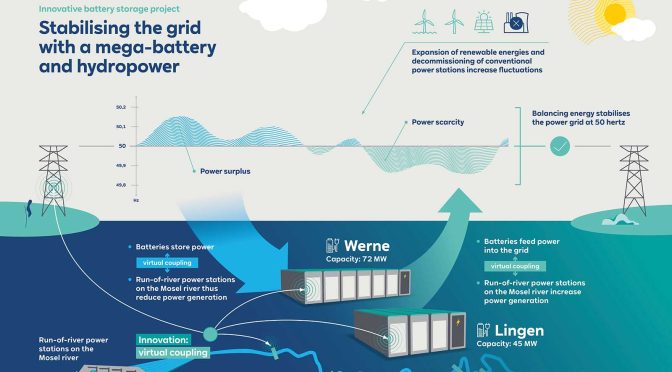Installation of Germany’s first megabattery is complete. In just 14 months, RWE succeeded in building a battery system with a total capacity of 117 megawatts (128 megawatt hours / MWh). Starting within seconds, the new system is capable of delivering the specified power for around an hour. A total of 420 blocks of lithium-ion batteries have been installed at RWE power plant sites in Lingen (Lower Saxony, 49 MWh) and Werne (North Rhine-Westphalia, 79 MWh). The company inaugurated the plant in Lingen in a ceremony attended by Christian Meyer, Lower Saxony’s Minister of the Environment and Energy.
Roger Miesen, CEO of RWE Generation, said: “With the increasing expansion of renewable energies, Germany needs innovative storage solutions on an industrial scale that can step in when the wind and sun are not supplying. In terms of size and technology, we are setting benchmarks in this country with our mega-battery. The completed battery storage facilities and our hydroelectric power plants on the Moselle will work hand in hand in the future to help stabilise the electricity grid.”
What makes the new battery storage system special is its virtual connection with RWE’s run-of-river power plants along the Moselle River. By selectively regulating the flow rate at these plants, RWE is able to provide additional power as balancing energy. As a result, the total capacity of power available for grid stabilisation in this system increases by up to 15 percent. The company has invested around 50 million euros into the megabattery project.
The battery storage system has already fed electricity into the grid and is currently going through a trial run. Commercial operation is scheduled to start in the next few days. Tests have also been successfully carried out on the software that RWE developed for intelligent linking to the Moselle power plants. Regular application of the programme is scheduled to start in the spring.
During the implementation of this project, RWE was able to draw on extensive in-house experience in energy storage systems. The company took exclusive control of project planning, modelling, system integration and commissioning. Also, because the megabattery takes advantage of available areas at RWE power plant sites, the batteries can utilise existing grid infrastructure to feed electricity in and out of the grid.
Battery storage systems are an essential part of the energy transition as they store the leftover electricity resulting from an overproduction in the grid and release it again when energy is needed. As a driving force behind the energy transition, RWE develops, builds, and operates battery storage systems in Europe, Australia, and the United States.
RWE is currently operating battery storage projects with an installed capacity of around 270 megawatts / MW (280 MWh), while completing battery storage projects around the world with a capacity of more than 700 MW (1,700 MWh). RWE aims to build battery storage systems with a total capacity of three gigawatts worldwide by 2030.
In Germany, at the end of 2022 RWE announced its investment decision for a new virtually networked 220 MW (235 MWh) battery storage project in Neurath and Hamm. The company also commissioned a solar plant with integrated battery storage at the site of its Inden opencast lignite mine, with two similar plants now under construction at its Garzweiler mine.
In its other projects, RWE makes use of storage systems from used electric car batteries (“second life” batteries) or liquid batteries known as RedOx flow systems. In addition, RWE offers industrial customers tailor-made, cutting-edge solutions, drawing on the company’s expertise in energy trading and innovative storage systems.


